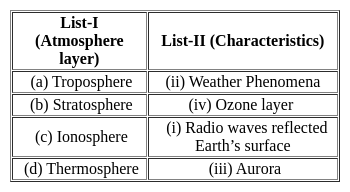UPSC CAPF Paper 1 Mock Test - 6 (General & Mental Ability) - CDS MCQ
30 Questions MCQ Test - UPSC CAPF Paper 1 Mock Test - 6 (General & Mental Ability)
Which one of the following guiding values of the Constitution of India means people have the supreme right to make decisions?
Which UN agency focuses on providing food assistance to countries in need?
Why did India and other small nations need to organise the NAM?
Due to which condition India has a wide range of natural vegetation
Which industries are also known as village or household industries?
Match List-I with List-II and select the correct answer using the codes given below:

Total utility is maximum when?
In India, in the overall index of industrial production, the indices of eight core industries have a combined weight of 37-90%. Which of the following is among those eight core industries?
1. Cement
2. Fertilizers
3.Naturalgas
4.Refinery products
5.Textiles
Select the correct answer using the codes given below:
Who won the gold medal in the 50m rifle 3P event at the 2023 Asian Shooting Championship?
Which country conferred the 'Order of the Druk Gyalpo' award to Indian Prime Minister Narendra Modi?
What is the name of the bi-annual exercise conducted by the Indian Navy off the Mumbai coast?
Rafah border crossing is located between which of the following?
Which Tokyo-based startup recently failed to become Japan's first private firm to put a satellite into orbit?
The book titled ‘Memories Never Die, was launched as a tribute to?
One atomic mass unit is a mass unit equal to exactly one twelfth (1/12th) the mass of one atom of ___________.
What happens when dilute hydrochloric acid is added to iron fillings?
The energy possessed by an oscillating pendulum of a clock is
Lonavala and Khandala are two stations 600 km apart. A train starts from Lonavala and moves towards Khandala at the rate of 25 km/h. After two hours, another train starts from Khandala at the rate of 35 km/h. How far from Lonavala will they will cross each other?
Consider the following pairs:

How many of the above pairs are correctly matched?
During the Delhi Sultanate, the designation 'Muqaddam or Chaudhari' was used for
Arrange the rulers of Vijayanagar in chronological order:
(I) Devaraya I
(II) Virupaksha
(III) Vir Narasimha
(IV) Krishnadeva Raya
(V) Tirumala
What were the reasons for the failure of the Cripps Mission:
1. The proposals were seen as too radical by the British and as too conservative by the INC who wanted complete independence
2. The Mission was rejected by the INC, the Muslim League and other Indian groups
Choose from the following options.
Which among the following are the directions given by Gandhi in the starting of salt disobedience?
1. Foreign liquor and clothes shops can be picketed
2. Government servants can resign from their posts
3. Lawyers will fight for the freedom fighters in the courts
Choose from the following options.
An eukaryotic cell ranges in size from:
The DNA is the genetic material was proved conclusively by :-
What happens when white light is passed from air to glass prism ?





















